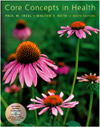Paul M. Insel,
Stanford University School of Medicine
Walton T. Roth,
Stanford University School of Medicine
| contraceptive | Any agent that can prevent conception; condoms, diaphragms, intrauterine devices, and oral contraceptives are examples.
|
 |
 |
 |
| conception | The fusion of ovum and sperm, resulting in a fertilized egg, or zygote.
|
 |
 |
 |
| sexually transmitted disease (STD) | Any of several contagious diseases contracted through intimate sexual contact.
|
 |
 |
 |
| barrier method | A contraceptive that acts as a physical barrier, blocking the sperm from uniting with the egg.
|
 |
 |
 |
| ovulation | The release of the egg (ovum) from the ovaries.
|
 |
 |
 |
| contraceptive failure rate | The percentage of women using a particular contraceptive method who experience an unintended pregnancy in the first year of use.
|
 |
 |
 |
| continuation rate | The percentage of women who continue to use a particular contraceptive after a specified period of time.
|
 |
 |
 |
| oral contraceptive (OC) | Any of various hormone compounds (estrogen and progestins) in pill form that prevent conception by preventing ovulation.
|
 |
 |
 |
| fertility | The ability to reproduce.
|
 |
 |
 |
| Pap test | A scraping of cells from the cervix for examination under a microscope to detect cancer.
|
 |
 |
 |
| abortifacient | An agent or substance that induces abortion.
|
 |
 |
 |
| intrauterine device (IUD) | A plastic device inserted into the uterus as a contraceptive.
|
 |
 |
 |
| male condom | A sheath, usually made of thin latex (synthetic rubber), that covers the penis during sexual intercourse; used for contraception and to prevent STDs.
|
 |
 |
 |
| ejaculation | An abrupt discharge of semen from the penis after sexual stimulation.
|
 |
 |
 |
| spermicide | A chemical agent that kills sperm.
|
 |
 |
 |
| diaphragm | A contraceptive device consisting of a flexible, dome-shaped cup that covers the cervix and prevents sperm from entering the uterus.
|
 |
 |
 |
| toxic shock syndrome (TSS) | A bacterial disease usually associated with tampon use, but can also occur in men; symptoms include weakness, cold and clammy hands, fever, nausea, and headache. TSS can progress to life-threatening complications, including very low blood pressure (shock) and kidney and liver failure.
|
 |
 |
 |
| cervical cap | A thimble-shaped cup that fits over the cervix, to be used with spermicide.
|
 |
 |
 |
| douche | To apply a stream of water or other solutions to a body part or cavity such as the vagina; not a contraceptive technique.
|
 |
 |
 |
| abstinence | Avoidance of sexual intercourse; a method of contraception.
|
 |
 |
 |
| fertility awareness method (FAM) | A method of preventing conception based on avoiding intercourse during the fertile phase of a woman's cycle.
|
 |
 |
 |
| sterilization | Surgically altering the reproductive system to prevent pregnancy. Vasectomy is the procedure in males; tubal sterilization or hysterectomy is the procedure in females.
|
 |
 |
 |
| vasectomy | The surgical severing of the ducts that carry sperm to the ejaculatory duct.
|
 |
 |
 |
| vasa deferentia | The two ducts that carry sperm to the ejaculatory duct; singular, vas deferens.
|
 |
 |
 |
| tubal sterilization | Severing or in some manner blocking the oviducts, preventing eggs from reaching the uterus.
|
 |
 |
 |
| laparoscopy | Examining the internal organs by inserting a tube containing a small light through an abdominal incision.
|
 |
 |
 |
| hysterectomy | Total or partial surgical removal of the uterus.
|
 |
 |
 |
| Sponge | A contraceptive device about 2 inches in diameter that fits over the cervix and acts as abarrier, spermicide, and seminal fluid absorbent.
|



 2002 McGraw-Hill Higher Education
2002 McGraw-Hill Higher Education

 2002 McGraw-Hill Higher Education
2002 McGraw-Hill Higher Education